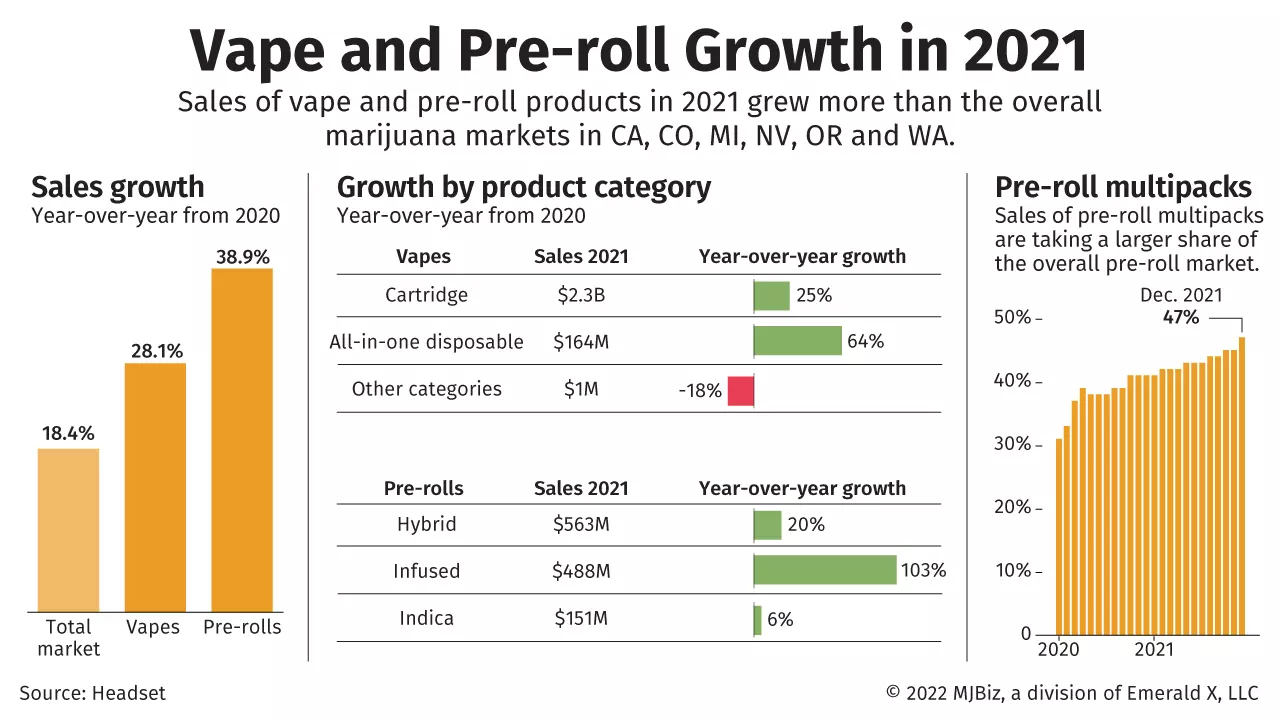Canadian sales of cannabis vape products continued to build from 2020 to 2021, with dollar sales up 79% and unit volume sales growing 100%, according to market data from Seattle-based cannabis data firm Headset.
The growth in vape market share comes amid declining prices and a consumer base that increasingly prefers larger cartridges filled with a gram of vape liquid instead of the half-gram format that initially dominated the market.
Meanwhile, the outlook for continued growth in the vape segment remains bright, according to an industry executive.
Mike Lickver, president of Toronto-based cannabis producer and manufacturer Auxly Cannabis Group, said Canadian vape market share still lags behind more mature U.S. recreational cannabis markets, “and I still think there’s lots of room for growth.”
However, Lickver believes Canada’s cannabis excise tax structure and potential regulatory restrictions on vape flavors pose challenges for the segment going forward.
The adult-use cannabis vape market in the four Canadian markets tracked by Headset – Alberta, British Columbia, Ontario and Saskatchewan – was worth 473.6 million Canadian dollars ($379 million) in 2021, with more than 11.9 million units sold.
Vape-market share expands
Canadian adult-use vape pens hit the market at the end of 2019 alongside other so-called “Cannabis 2.0” derivative products like edibles and concentrates.
Vape pen sales growth of 79% between 2020 and 2021 outpaced total cannabis market sales growth of 61%, indicating improved market share for the smokeless devices, observed Headset senior data analyst Cooper Ashley.
“They increased their relative market share by about 11%, from 14.7% of sales in 2020 to 16.3% of sales in 2021,” he said.
Vapes, including battery-less cartridges filled with vape liquid and all-in-one disposable vape pens, were the third-largest Canadian cannabis product category by market share in 2021, after cannabis flower (48.5%) and pre-rolls (20.3%).
“That’s a pretty quick rise to a dominant position in the market, and they’re the most successful Cannabis 2.0 category,” Ashley said.
The sales growth came as vape prices fell by 35% over the course of the year, based on price data that reflects different product size formats for cannabis products.
That indicates that prices are becoming more competitive and also suggests a shift from half-gram vape cartridges toward the larger 1-gram format, a trend Ashley said Headset has also observed in U.S. cannabis markets such as California.
Stay informed with MJBiz Newsletters
MJBiz’s family of newsletters gives cannabis professionals an edge in this rapidly changing industry.
Featured newsletters:
- MJBizDaily: Business news for cannabis leaders in your inbox each morning
- MJBiz Cultivator: Insights for wholesale cannabis growers & vertically integrated businesses
- MJBizCon Buzz: Behind-the-scenes buzz on everything MJBizCon
- MJBiz Retail + Brand: New products, trends and news for cannabis retailers, distributors and marketers
- Hemp Industry Week: Roundup of news from hemp farming to CBD product manufacturing
- And more!
What Canadian vape consumers want
Heather Huff-Bogart, owner and operator of independent retailer The Green Bouquet Cannabis in Huntsville, Ontario, has seen increased consumer interest in the 1-gram format, “with a caveat.”
“It comes down to the quality of the vape – a lot of people like the 1-gram vapes because it lasts them longer, and it’s more value for their dollar,” Huff-Bogart said.
“But also, there’s lots of comments (that) the 1-grams get clogged more often,” she added.
“So a lot of people will go to the half-gram, so then they don’t have to deal with that.”
Auxly Cannabis, which holds a leading position in Canada’s recreational vape market via multiple brands, was the first Canadian company to launch 1-gram vape cartridges in late 2020, Lickver said.
“And if you look at the progression of that, I would say 60% of the (cartridge) market is now 1-gram format – so there’s been a massive shift to larger format size,” he said.
Canadian consumers have also migrated toward “strain-specific” vapes with “identifiable flavors” rather than vapes labeled simply as indica, sativa or hybrid, Lickver added.
Vape price compression
Lickver pointed out that falling Canadian vape prices in 2021 came amid increased competition in the segment.
At the end of 2020, Lickver said, Canada had 61 vape brands with 350 stock-keeping units (SKUs).
By the end of 2021, there were 100 brands with 523 SKUs.
At the same time, Lickver said the regulated industry is competing against illicit cannabis vapes.
“We’re still battling that fight every day, and that does trend into price compression in vapes, absolutely,” he said.
Lickver believes profit margins for some of Auxly’s competitors in the vape segment are “extremely thin” and said that keeping the segment profitable involves economies of scale and improving efficiency.
Current federal cannabis excise taxes also pose a challenge, he suggested.
“I think it is important to identify that we’re paying close to CA$10 in excise (tax) for a 1-gram vape pen,” Lickver said.
“So it’s extremely difficult to continue with healthy margins if price compression continues on this trend.”
Future of Canadian vapes
Lickver sees growth opportunities in the vape category by continuing to convert users from the illicit market.
“That just comes with price competition, which we already have, convenience, delivery – all of those things are getting better day after day.”
Headset analyst Ashley said Canadian vape pen market share is holding steady so far in 2022 and vape market share has remained above 17% since November 2021 in the provinces Headset tracks.
“If we’re going to project based off some other, more mature, U.S. markets and their trends over time, there’s definitely room for growth here,” Ashley said.
Ontario retailer Huff-Bogart sees a trend of vape shoppers seeking cartridges containing “more of the live terpenes – something other than just (THC) distillate.”
“They’re looking for the full-spectrum (vape products), they’re starting to get more interested in the other offerings of vapes that are out there, too.”
Auxly’s Lickver sees the same trend.
“I think we’re starting to see more sophisticated users looking for a more true-to-plant experience. … Whether it’s live resin, live rosin, liquid diamonds, you can look to more mature markets to see the trend there,” he said.
Lickver also sees increasing interest in vapes containing minor cannabinoids such as CBN or CBG.
“To date, vapes have really been THC or CBD, or a combination of those two of the dominant cannabinoids,” he said.
“I think you’re going to see a shift to minors,” he added. “You’re already seeing it in edibles.”
Meanwhile, Lickver has his eye on Canadian regulatory changes that could restrict vape flavors, warning that such a move “could impact the vape market significantly.”
Lickver also sees possibilities for new vape hardware formats beyond the ubiquitous screw-on, 510-thread cartridge.
“We think there’s room for a more user-friendly, customizable, better user experience,” he said.
“There is room for more technology, closed-loop systems, and eventually, really an overhaul on the hardware side.”
Huff-Bogart believes increased adoption of proprietary cannabis vape pods would require more education from producers to retailers like herself.
“I think they would have to teach the retailer, or get the retailer excited, in turn, for us to be able to sell it to the customer,” Huff-Bogart explained.
“Because we would have to get them excited and curious about the products, for us to be bringing in that kind of a new technology when everybody’s so adapted to the 510 right now, or even the disposable (vape) pens.”
Solomon Israel can be reached at solomon.israel@mjbizdaily.com.





